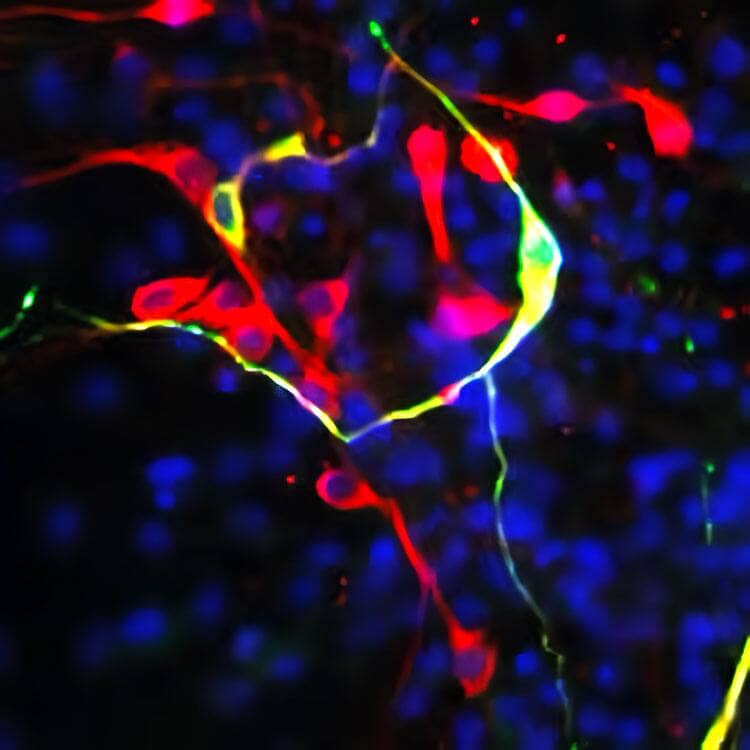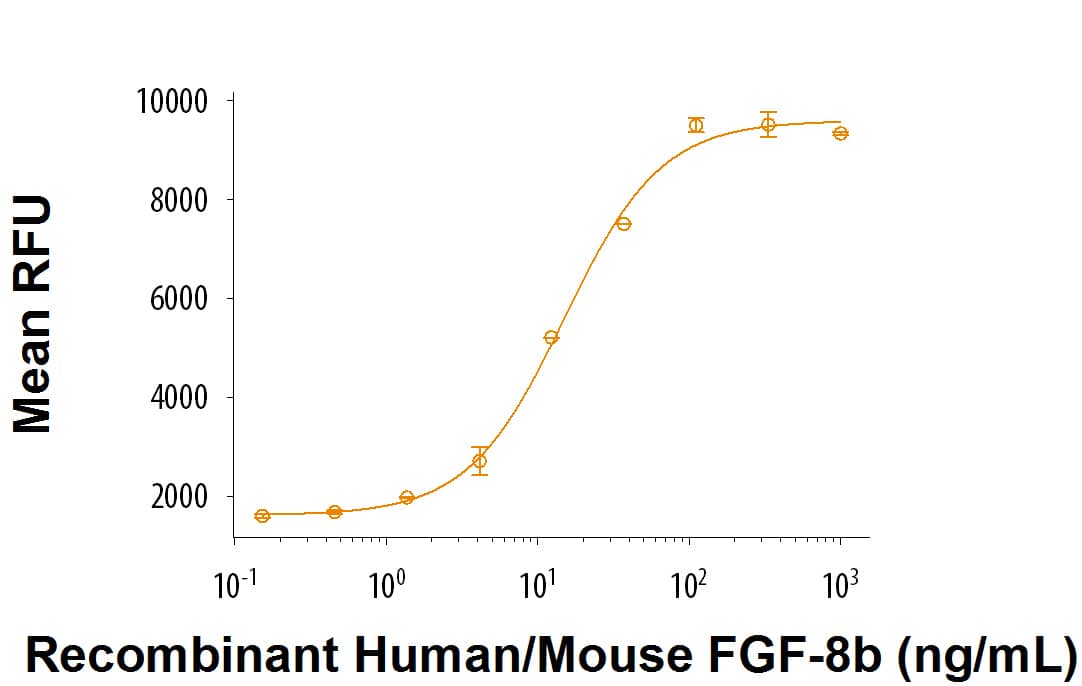Recombinant Human/Mouse FGF-8b Protein Best Seller
R&D Systems, part of Bio-Techne | Catalog # 423-F8

Key Product Details
Source
Accession #
Conjugate
Applications
Product Specifications
Source
Gln23-Arg215, with an N-terminal Met
Purity
Endotoxin Level
N-terminal Sequence Analysis
Predicted Molecular Mass
SDS-PAGE
Activity
The ED50 for this effect is typically 6.5-40 ng/mL in the presence of 1 µg/mL heparin.
Reviewed Applications
Read 3 reviews rated 5 using 423-F8 in the following applications:
Scientific Data Images for Recombinant Human/Mouse FGF-8b Protein
Recombinant Human/Mouse FGF-8b Protein Bioactivity
Recombinant Human/Mouse FGF-8b (Catalog # 423-F8) stimulates cell proliferation in the NR6R‑3T3 mouse fibroblast cell line. The ED50 for this effect is 6.5-40 ng/mL in the presence of 1 μg/mL heparin.Recombinant Human/Mouse FGF-8b Protein SDS-PAGE
1 μg/lane of Recombinant Human/Mouse FGF-8b was resolved with SDS-PAGE under reducing (R) conditions and visualized by silver staining, showing a single band at 23 kDa.Culture and Characterization of Dopaminergic Neurons Generated from Human Pluripotent Stem Cells.
Dopaminergic neurons were generated from human pluripotent stem cells in media that included Bovine Fibronectin Protein (1030-FN) to support cell attachment and spreading, the ITS and N-2 Plus Media Supplements (AR013 and AR003, respectively) to select and enrich for neural stem cell populations, and a panel of growth factors for effective dopaminergic differentiation, including Recombinant Human FGF-basic, Recombinant Mouse FGF-8b (Catalog # 423-F8), and Recombinant Mouse Shh-N (464-SH). Cells were stained with a Mouse Anti-Human/Mouse Tyrosine Hydroxylase Monoclonal Antibody (MAB7566) followed by a NorthernLights™ 493-conjugated Donkey Anti-Mouse IgG Antigen Affinity-purified Secondary Antibody (NL009; green), and a Mouse Neuron-specific beta III Tubulin Tuj1 Monoclonal Antibody (MAB1195) followed by a NorthernLights 557-conjugated Donkey Anti-Mouse IgG Antigen Affinity-purified Secondary Antibody (NL007; red) and counterstained with DAPI (5748; blue).Formulation, Preparation and Storage
Carrier Free
What does CF mean?CF stands for Carrier Free (CF). We typically add Bovine Serum Albumin (BSA) as a carrier protein to our recombinant proteins. Adding a carrier protein enhances protein stability, increases shelf-life, and allows the recombinant protein to be stored at a more dilute concentration. The carrier free version does not contain BSA.
What formulation is right for me?In general, we advise purchasing the recombinant protein with BSA for use in cell or tissue culture, or as an ELISA standard. In contrast, the carrier free protein is recommended for applications, in which the presence of BSA could interfere.
Carrier: 423-F8
| Formulation | Lyophilized from a 0.2 μm filtered solution in MOPS, Na2SO4 and Brij-35 with BSA as a carrier protein. |
| Reconstitution | Reconstitute at 25 μg/mL in sterile PBS containing at least 0.1% human or bovine serum albumin. |
| Shipping | The product is shipped at ambient temperature. Upon receipt, store it immediately at the temperature recommended below. |
| Stability & Storage | Use a manual defrost freezer and avoid repeated freeze-thaw cycles.
|
Carrier Free: 423-F8/CF
| Formulation | Lyophilized from a 0.2 μm filtered solution in MOPS, Na2SO4 and Brij-35. |
| Reconstitution | Reconstitute at 100 μg/mL in sterile PBS. |
| Shipping | The product is shipped at ambient temperature. Upon receipt, store it immediately at the temperature recommended below. |
| Stability & Storage | Use a manual defrost freezer and avoid repeated freeze-thaw cycles.
|
Background: FGF-8
FGF-8 is a member of the fibroblast growth factor family that was originally discovered as a growth factor essential for the androgen-dependent growth of mouse mammary carcinoma cells (1-3). Alternate splicing of mouse FGF-8 mRNA generates eight secreted isoforms, designated a-h, but only FGF-8a, b, e and f exist in humans (4). FGF-8 contains a 22 amino acid (aa) signal sequence, an N‑terminal domain that varies according to the isoform (30 aa for FGF-8b; 20 aa for the shortest, FGF-8a), a 125 aa FGF domain and a 37 aa proline‑rich C‑terminal sequence. The FGF domain of FGF-8 shares the most aa identity with FGF17 (75%) and FGF-18 (67%), and the three form an FGF subfamily (2). Mouse FGF-8b shares 100% aa identity with human FGF-8b. FGF-8 is widely expressed during embryogenesis, and mediates epithelial-mesenchymal transitions. It plays an organizing and inducing role during gastrulation, and regulates patterning of the midbrain/hindbrain, eye, ear, limbs and heart in the embryo (2, 5 - 8). The isoforms may play different roles in development. FGF-8b shows the strongest receptor affinity and oncogenic transforming capacity although FGF-8a and FGF-8e are also transforming and have been found in human prostate, breast or ovarian tumors (1, 5, 9-12). FGF-8 shows limited expression in the normal adult, but low levels are found in the reproductive and genitourinary tract, peripheral leukocytes and bone marrow hematopoietic cells (3, 9, 13).
References
- Mattila, M.M. and P.L. Harkonen (2007) Cytokine Growth Factor Rev. 18:257.
- Reuss, B. and O. von Bohlen und Halbach (2003) Cell Tiss. Res. 313:139.
- Tanaka, A. et al. (1992) Proc. Natl. Acad. Sci. USA 89:8928.
- Gemel, J. et al. (1996) Genomics 35:253.
- Olsen, S.K. et al. (2006) Genes Dev. 20:185.
- Crossley, P.H. et al. (1996) Cell, 84:127.
- Heikinheimo, M. et al. (1994) Mech. Dev. 48:129.
- Sun, X. et al. (1999) Genes Dev. 13:1834.
- Ghosh, A.K. et al. (1996) Cell Growth Differ. 7:1425.
- Mattila, M.M. et al. (2001) Oncogene 20:2791.
- Valve, E. et al. (2000) Int. J. Cancer 88:718.
- Valve, E.M. et al. (2001) Lab. Invest. 81:815.
- Nezu, M. et al. (2005) Biochem. Biophys. Res. Commun. 335:843.
Long Name
Alternate Names
Gene Symbol
Additional FGF-8 Products
Product Documents for Recombinant Human/Mouse FGF-8b Protein
Product Specific Notices for Recombinant Human/Mouse FGF-8b Protein
For research use only



